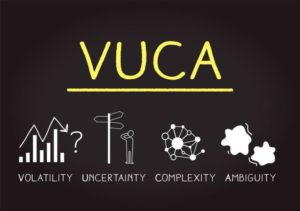 Understanding Which Enterprise Agility Strategy Might be Right for Your Organization
Understanding Which Enterprise Agility Strategy Might be Right for Your Organization
Many organizations begin their agile journey by forming agile teams in one or more functional areas, such as IT, marketing, and new product development. When they saw the results of improved time to market, lower cost, and higher employee engagement, they decide to adopt the framework across the enterprise. These enterprise agility initiatives are implemented using a variety of approaches, including Safe® or other customized agile transformation strategies, often branded internally by the organization. I won’t go into each enterprise approach in detail but want to help you distinguish between those that are sometimes used (mistakenly) interchangeably.
To help you begin to explore which approach may be right for your organization, in this second post of my Agile 101 series, I share very brief overviews to distinguish each along with links to fuller descriptions and examples to help you consider if an enterprise agility strategy is right for you.
Agile Transformation
 While more common in smaller organizations, large enterprises now recognize their urgent need to be more nimble to stay competitive in a rapidly changing marketplace. An increasingly favored strategy is to scale agile methodologies, such as Scrum, across the organization. Businesses, as varied as Ericsson, CapitalOne, and most notably, Amazon, have adopted this approach to improve the speed and quality of the products and services they bring to market. Here are brief descriptions of the most favored approaches.
While more common in smaller organizations, large enterprises now recognize their urgent need to be more nimble to stay competitive in a rapidly changing marketplace. An increasingly favored strategy is to scale agile methodologies, such as Scrum, across the organization. Businesses, as varied as Ericsson, CapitalOne, and most notably, Amazon, have adopted this approach to improve the speed and quality of the products and services they bring to market. Here are brief descriptions of the most favored approaches.
SAFe® (Scaled Agile Framework) is the most common and fully developed approach to agile transformation, currently being used to some degree or another by 70% of Fortune 100 companies (according to the SAFe® website). With its roots in software development, the goal of the SAFe® approach is to create a Lean enterprise.
Digital Transformation: describes the process whereby an organization moves all of its business operations, including people, processes, systems, and customer interactions to technology-based interfaces. For many, but not all, this includes a cloud-based strategy. Disrupters in every sector (think Amazon, Uber/Lyft, even companies like Quicken Loans) are forcing their competitors to adopt digital strategies, as well, if they want to stay competitive.
For a more complete overview and examples of digital transformation, I recommend Clint Boulton’s recent piece for CIO. Digital transformations, while not the same as agile, can certainly benefit from their ability to execute complex projects rapidly, as many organizations are finding. After all, you cannot improve agility using mindsets and approaches designed for another era.
DevOps: In its essence, DevOps is the convergence of Development and Operations and has roots in agile methodologies. The DevOps movement was sparked by software developers’ frustrations. While they were adopting agile methodologies in their teams, they encountered obstacles in actually releasing code and collaborating across organizational silos.
DevOps emerged as a strategy to integrate system-wide structures and processes to ensure that the communication, collaboration, and coordination of agile carried throughout the organization. In this sense, DevOps is a specific type of agile transformation. Atlassian, a leader in large-scale DevOps strategies and systems, has a more in-depth overview on their site.
When You Should Consider an Enterprise Agility Approach
All approaches to enterprise agility can only thrive with engaged support from leaders throughout the organization who have themselves made the mindset shift necessary for a radical new way of working to take root. These leaders must also recognize the need to foster and sustain an organizational culture that values whole systems thinking, broad transparency, and understands their organization as a human system of interactions, not merely a series of operational transactions.
![]() Critical Success Factors: Scaling agile transformation requires communication, collaboration, and coordination of stakeholders and contributors across the enterprise, as well as the integration and, often, disruption of well-established systems and processes.
Critical Success Factors: Scaling agile transformation requires communication, collaboration, and coordination of stakeholders and contributors across the enterprise, as well as the integration and, often, disruption of well-established systems and processes.
You should only consider a scaled agile approach if you have broad leadership commitment and resources to follow through. This commitment includes embracing the urgent business case for a radical change, along with the acceptance that leaders at all levels of the organization will be asked to make a significant mindset shift that will take them out of their comfort zones.
This shift may impact your leaders’ familiar ways of thinking and working, as well as their roles and even their hard-earned status. To support this formidable transition, organizations such as Ericsson established Centers of Excellence as central hubs to coordinate the transformation, as well as to provide training, coaching, and support across the organization early in their transformation.
At Meyer Agile Innovation, Inc. we are working with clients who, rather than rely on a central hub, are developing Agility Champions throughout the organization to serve as resources, coaches and guides on the side to support individual and team success through their agile transformation.
 If your business is operating in a rapidly changing VUCA environment and has the understanding, commitment, resources, and willingness to persevere through a complex process, agile transformation could well be worth your investment.
If your business is operating in a rapidly changing VUCA environment and has the understanding, commitment, resources, and willingness to persevere through a complex process, agile transformation could well be worth your investment.
In my next and final post of this series Agile 101: Developing Agile Leaders, I make a case for and provide an overview of the mindset and cultural shift, as well as the six dynamics of the Agility Shift that are crucial to realizing the results of any agile transformation.
How agile is your Talent Development Strategy?
Pamela Meyer, Ph.D., is the author of The Agility Shift: Creating Agile and Effective Leaders, Teams and Organizations. As president of Meyer Agile Innovation, she is a sought-after keynote speaker and works with leaders and teams across industries who need innovative learning and talent development strategies to make the mindset and business shift to compete in a rapidly changing marketplace.
